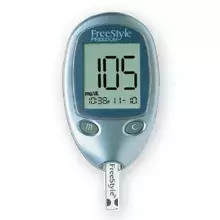People with diabetes always seem most interested in seeing the dietitian so they can learn what they can and can't eat. They just want a list to make their lives easier – or more torturous, however you look at it. Of course, to be healthy with or without diabetes, you want to follow some basic rules:
- Refrain from fried foods when possible.
- Limit saturated fat foods. Try to stay away from butter, cream, cream sauces, fatty meats, skin on poultry, pastries, donuts, cookies, and full fat dairy foods like cheese, milk, ice cream, and yogurt (choose fat free). Your arteries will thank you for it!
- Limit high-sodium foods. Avoid too many processed, prepared, canned foods such as soups, cold cuts, cheeses, bacon, sauces, gravies and dressings. Enjoy salty snacks like chips in moderation.
- Limit an abundance of soda. The carbonation in regular or diet sodas may weaken your bones. Instead, try water with a few pieces of frozen fruit for a natural, refreshing flavored alternative.
- Reduce processed foods. Processed foods typically contain more sodium, fat and sugar. One popular recommendation is to shop on the "outside aisles" in the grocery store where the fresh foods are normally located.
- Consume foods with less than 5 grams of processed sugar. Processed sugar in too high of a quantity is not good for anyone. A couple of foods where it is okay to consume sugars include fruit (fructose) and milk (lactose) sugar.
Level blood sugar results in better energy, improved moods and less mood swings. Fewer spikes and dips in blood sugar levels also result, which are healthier for the body AND controlling the appetite. The following is recommended:
- Combine food groups like carbohydrates, protein and fat, using healthy choices.
- Consume your meals and snacks 3-4 hours apart. This allows you to be satisfied with your choices without stuffing yourself. Knowing you will be eating every 3 -4 hours allows you to eater smaller portions, which has a more moderate affect on your blood sugar rise. By eating more often, your metabolism will allow you to "burn" more calories.
- Use the above recommendations instead of placing yourself on the dreaded "diet." This four-letter-word tends to be a short-term fix and then many of us fail at the diet game.
Diets can also leave us thinking about food all the time. Rather, use common sense while making choices. Think in more general terms and then test your blood sugar right before a meal and 2 hours later after the start of that meal.
Remember, your body can't process a high level of carbs at one time efficiently, so you need to reduce the amount of carbohydrates you eat at one time.
Here's an example: For breakfast, you decide you would like to have oatmeal (we know that's healthy!) with fruit and milk. You need to think to yourself, "My breakfast is full of carbs - starch (oatmeal), fruit and milk. They all turn 100% into sugar in 1-2 hours!" If you take a more moderate amount of oatmeal (about 1 cup cooked), one fruit serving and ½ cup milk and test your blood sugar before you start eating, and once again 2 hours after the start of your meal, then you should be able to tell how well your body processed that meal.
What numbers are we looking for? Approximately a 50-point rise in blood sugar is acceptable 2 hours after you consume a meal. If your blood sugar rises much more, then you need to re-evaluate what you ate, and the portions you consumed. You may need to cut back on the carb amount and add some protein. You may also need a medication adjustment. Also, remember to carry glucose tablets for low blood sugar episodes.
Contributor: Article adapted from "Tips for Better Blood Sugar Control" by Marci Sloane, MS, RD, LD/N, CDE.

